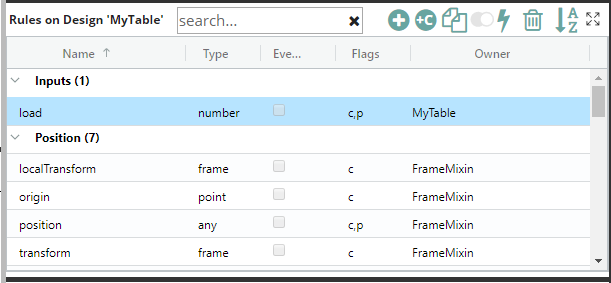As you continue to develop your table, you begin by adding a Rule for load - that is, the mass that the table top and legs must support.
The load is an input representing mass that will have a ripple effect through our Model. A heavier load will result in a table with bigger (thicker) components and a lighter load will result in a table with smaller components.
The load Rule
In the following steps, you will be creating your rule for load.
1. Click on MyTable in the Model tree.
2. Click on the Design Context tab
3. In the Rules Grid, click on the + icon (Add Design Rule)

4. The Rule Editor is immediately visible. Note the input slots, as follows:
•Name
•Type
•Flags
•Category.
•Formula input, where you create the rule's expression

Name, Type, and Flags are important to specify for Rules. Category determines the group headings under which Parameters are listed in the Rules / Parameters grid. Finally, there is a Formula input slot where you enter the Expression of a Rule—above, it is in the default value, 0.0
Note: the default Type of a new Rule is "number." The cached flag is automatically set for all new Rules. In this Project, do not remove (uncheck) the cached flag. It has an important function that keeps the Rule's value in memory.
5. Enter Rule Name: "load"
6. Retain Type: number

7. Specify under Flags, "cached" (meaning that the Rule's value is saved - not re-calculated if it is referenced by another Rule) and "Parameter" (can be supplied as an input to the Design)
8. Enter the load Rule value: 250
9. Select "Inputs" as the Category. If "Inputs" is not available on the drop-down list, simply erase "None" and type "Inputs" into the drop-down's box. The Input category will now persist throughout your MyTable Project
10. Click Apply at the upper right of the Context pane.

Note that "Load" is now the single Rule under the "Inputs" Rules listed for the Table model:

In summary, you have created the following:
Table Design Rule |
|||
Name: |
Load |
Special Instructions: |
|
Type: |
number |
|
|
Flags: |
cached, Parameter |
Category: |
Inputs |
Formula: |
250 |
||